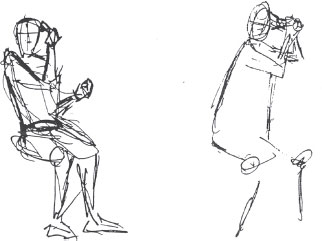Last week I attended an animator’s meeting held at the Hart building. It was a most inspiring session and everyone present seemed to be enthusiastic about it. I hope such meetings can be an ongoing happening. James Baxter showed a British Television comedy and handed out some material that Richard Williams has been collecting — possibly for future publication.
As I glanced through the writings and quotes of the contributors, one thing that stood out in each animators approach was: think first, then draw. Let me just quote some of them briefly. And bear in mind these are not just “aids” for drawing — these are basic to their way of working,
9 out of 10 times before I animate I know exactly what I’m going to do. The worst thing you can do is to get into anything before you know what you’re doing.
Milt Kahl
Think about your work before you sit down to do it. You must think and plan — you can’t wing it.
Art Babbitt
Planning it so that you know exactly where you’re going…
Grim Natwick
I think it’s in the planning. If you can plan the stuff out so you really know exactly what you’re gonna do … if you know exactly what you’re going to do — and have it visualized — why you can do it pretty fast.
Ollie Johnston
“The only advice I know is to think it all out in your mind and then draw it the best you can….
Ken Harris
In a class such as we have on Tuesday and Wednesday evenings, it is very difficult to get into specifics of animation. One thing that is missing when making a single drawing is the advantage of watching the change take place in the poses as you flip one drawing over another. For instance, having an anticipation drawing on your pegs makes it easier to draw a stretch drawing coming out of it. I emphasized easier because I’d like to suggest that just because it’s easier, does not mean it is the only way of drawing a stretch drawing. I have always said that drawing is a mental activity, especially when drawing for animation, which is inextricably tied in with the story. The whole purpose of drawing is to put over a story point, and that story point has to be firmly established first in the mind before starting a drawing.
So in a classroom situation, the artists should realize that every pose is the study of a gesture. If the drawing happens to involve a stretch, then in the absence of another drawing to flip from, a good approach would be to imagine where the figure had come from (anticipatory pose). This is tantamount to saying that every drawing you make should be an action analysis exercise. In other words, ask yourself “What is the story here and how would this gesture fit into a bit of animation action?” That is the mental side of drawing.
Let’s consider how one might “think through” a pose. Take, for instance, a woman sitting down, brushing her hair. First of all there should be a feeling of squash where her body is plunked down on the chair. No real need for another drawing to flip from — a squash is a squash. It doesn’t need to be spread all over the chair seat but it should look as though it is supporting the weight of her upper body. She pulls at her hair with her brush. Naturally she would lean into the pull to free her hair from her neck and shoulders causing a stretch in the direction of the pull. To help that action you might use the opposite leg to help push the body into the action. You might tilt the head in the direction of the pull of the brush to emphasize that activity. You might show some of the hair being pulled away from the head in a good clean silhouette and angle the arms to help in the outward pull of the brushing. You don’t need another drawing to figure all this out. You just need to know what is happening and then incorporate the principles of drawing and physics to illustrate that.
It just so happens that there was such a pose in one of our recent drawing sessions. One of the drawings was coming off in a rather stilted manner. There seems to be a kind of intellectual attempt to incorporate angles, anatomy, negative shapes, and clarity in the drawing. But one thing seems to be missing — a total involvement on the part of the woman in brushing her hair. My accompanying sketch is an attempt to make brushing her hair the story point and to direct all attention to that one thing. I agree that a great variety of poses will be employed as a woman brushes her hair. The artist’s may well be one of them. Or perhaps the story point could have called for the woman to hear something disturbing, like a burglar trying to pry open the bedroom window, and she freezes in this position as she listens.

A gesture is a body doing something. Certain things have to happen to facilitate the body in doing it. Those certain things are the things we are interested in, whether it is in an animation drawing or in a simple still drawing. Better yet, it is the mental manipulation that helps us find those things that we are interested in, for if we can picture the gesture in our minds, then we can draw it.
